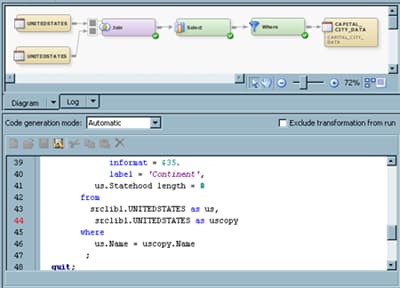Joining a Table to Itself
Problem
You need
to produce a subset of information that is based on the relationship
between columns in the same table.
Solution
You can
join the table to itself by creating the second version of the table
with an alias. Then, you can create a query to compare data from columns
in the original table to other columns in the aliased table.
Tasks
Join the Table to Itself
Perform
the following steps to join a table to itself and use the resulting
hierarchy of tables in a query:
-
Open the Designer window for the SQL Join transformation. Click Create in the Navigate pane to access the Diagram tab and the SQL Clauses pane.
-
Drop the same table that was used as a source table for the query in the Diagram tab. You are prompted to supply an alias for the table because it is already being used as a source table for the query. Enter the alias in the Alias field of the properties pane for the table. The dialog box for the alias is shown in the following display.Self-Join Alias Dialog Box

-
Complete any additional configuration needed to finish the query. The following display shows a sample job that includes a table joined to itself.Sample Job with a Table Joined to Itself

The tables
in the flow shown on the Diagram tab are
reflected in the FROM clause that is highlighted on the Code tab below it. The query that is shown in the sample job pulls the Name variable from
the original table (denoted with the
us alias). However, it pulls the
Population and Area variables from the copy of the original table
(denoted with the uscopy alias).
Copyright © SAS Institute Inc. All Rights Reserved.
Last updated: January 16, 2018